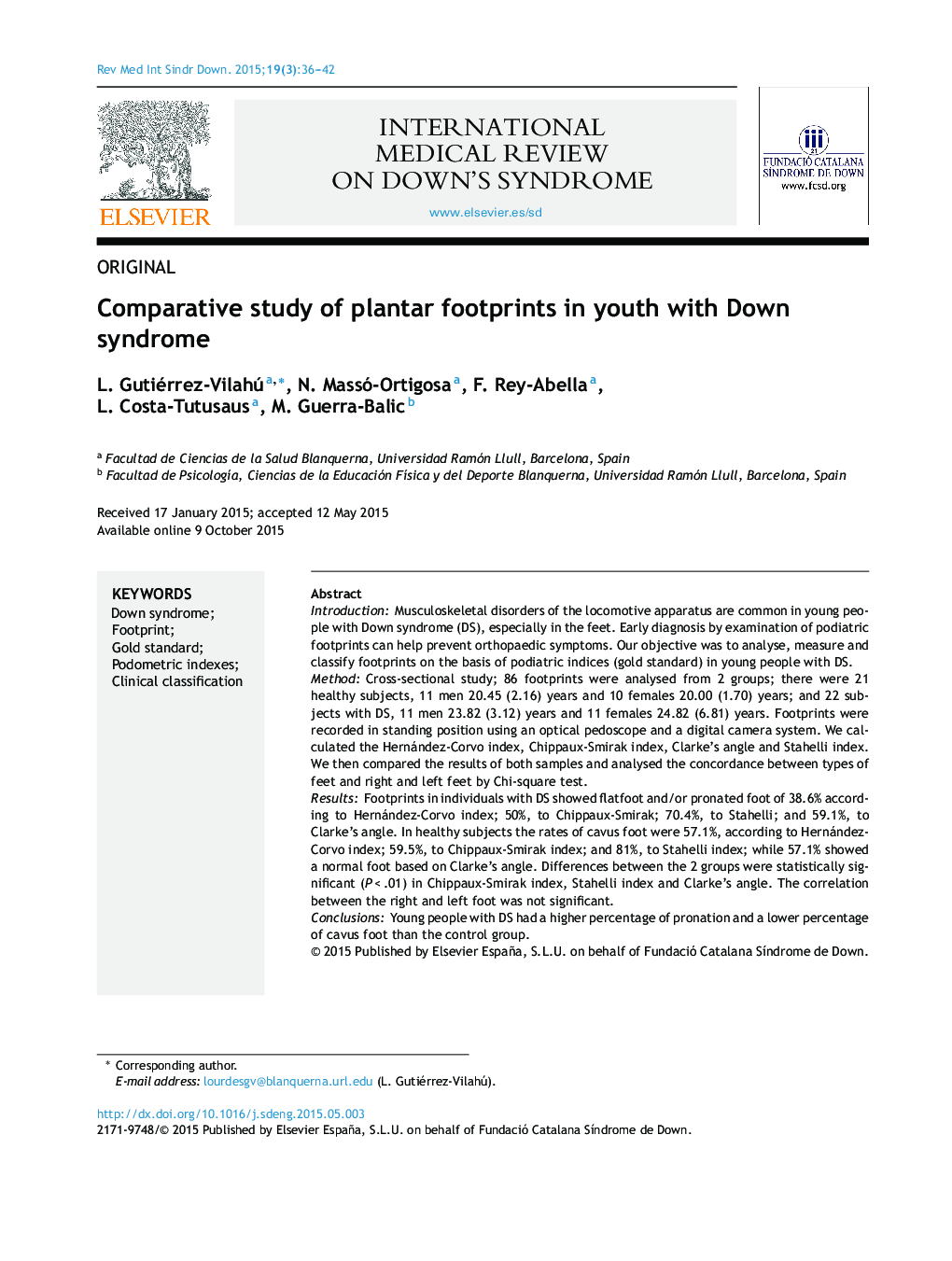| کد مقاله | کد نشریه | سال انتشار | مقاله انگلیسی | نسخه تمام متن |
|---|---|---|---|---|
| 917728 | 919391 | 2015 | 7 صفحه PDF | دانلود رایگان |
IntroductionMusculoskeletal disorders of the locomotive apparatus are common in young people with Down syndrome (DS), especially in the feet. Early diagnosis by examination of podiatric footprints can help prevent orthopaedic symptoms. Our objective was to analyse, measure and classify footprints on the basis of podiatric indices (gold standard) in young people with DS.MethodCross-sectional study; 86 footprints were analysed from 2 groups; there were 21 healthy subjects, 11 men 20.45 (2.16) years and 10 females 20.00 (1.70) years; and 22 subjects with DS, 11 men 23.82 (3.12) years and 11 females 24.82 (6.81) years. Footprints were recorded in standing position using an optical pedoscope and a digital camera system. We calculated the Hernández-Corvo index, Chippaux-Smirak index, Clarke's angle and Stahelli index. We then compared the results of both samples and analysed the concordance between types of feet and right and left feet by Chi-square test.ResultsFootprints in individuals with DS showed flatfoot and/or pronated foot of 38.6% according to Hernández-Corvo index; 50%, to Chippaux-Smirak; 70.4%, to Stahelli; and 59.1%, to Clarke's angle. In healthy subjects the rates of cavus foot were 57.1%, according to Hernández-Corvo index; 59.5%, to Chippaux-Smirak index; and 81%, to Stahelli index; while 57.1% showed a normal foot based on Clarke's angle. Differences between the 2 groups were statistically significant (P < .01) in Chippaux-Smirak index, Stahelli index and Clarke's angle. The correlation between the right and left foot was not significant.ConclusionsYoung people with DS had a higher percentage of pronation and a lower percentage of cavus foot than the control group.
ResumenIntroducciónLos trastornos musculoesqueléticos a nivel del pie son frecuentes en las personas con síndrome de Down (SD). Por ello el diagnóstico precoz mediante examen podológico de las huellas plantares puede ayudar a prevenir las manifestaciones ortopédicas. El objetivo es analizar, medir y clasificar la huella plantar mediante los índices podológicos (gold standard) en jóvenes con SD.MétodoEstudio transversal comparativo; se analizaron 86 huellas plantares correspondientes a 2 grupos: 21 sujetos sin SD, 11 hombres de 20,45 (2,16) años y 10 mujeres de 20 (1,70) años; y 22 sujetos con SD, 11 hombres de 23,82 (3,12) años y 11 mujeres de 24,82 (6,81) años. Se registraron las huellas plantares en bipedestación estática mediante la utilización de un podoscopio óptico y una cámara digital. Los índices analizados son Hernández-Corvo, Chippaux-Smirak, Stahelli y ángulo de Clarke. Se compararon los resultados de ambas muestras y se analizó la concordancia entre los tipos de pies, derecho e izquierdo, mediante la prueba de Chi-cuadrado.ResultadosLos sujetos con SD se clasifican con pie plano y pronador en un 38,6% según el índice de Hernández-Corvo; Chippaux-Smirak 50%; Stahelli 70,4%; y ángulo de Clarke 59,1%. Los sujetos control presentan pies cavos en un 57,1% según el índice de Hernández-Corvo; Chippaux-Smirak 59,5%; Stahelli 81%; y como pie normal según el ángulo de Clarke en un 57,1%. Hay diferencia significativa (p < 0,01) en los índices Chippaux-Smirak, Stahelli y el ángulo de Clarke. La concordancia entre pie derecho e izquierdo no fue significativa.ConclusiónLos jóvenes con SD presentan más porcentaje de pie plano pronador y menos cavos que el grupo control.
Journal: International Medical Review on Down Syndrome - Volume 19, Issue 3, September–December 2015, Pages 36–42
